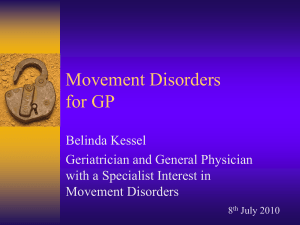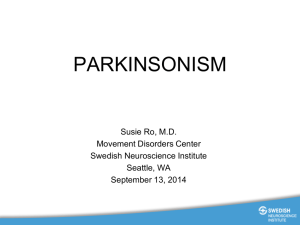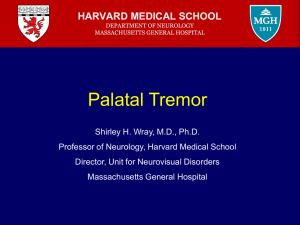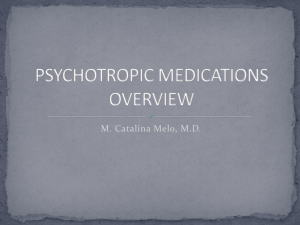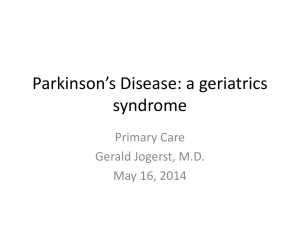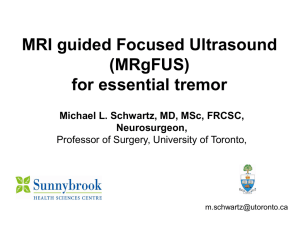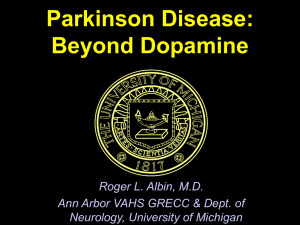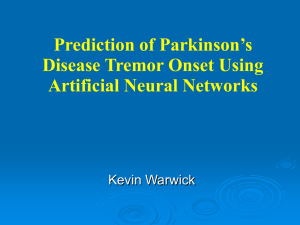Medical Management of Parkinson`s Disease
advertisement
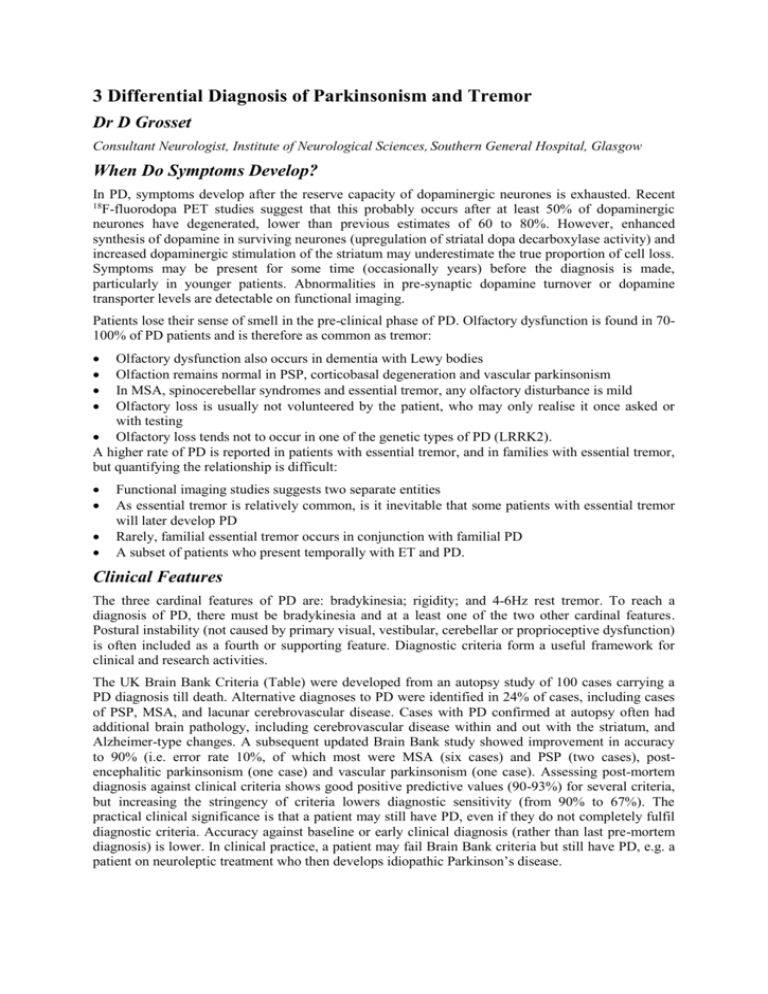
3 Differential Diagnosis of Parkinsonism and Tremor
Dr D Grosset
Consultant Neurologist, Institute of Neurological Sciences, Southern General Hospital, Glasgow
When Do Symptoms Develop?
In PD, symptoms develop after the reserve capacity of dopaminergic neurones is exhausted. Recent
18
F-fluorodopa PET studies suggest that this probably occurs after at least 50% of dopaminergic
neurones have degenerated, lower than previous estimates of 60 to 80%. However, enhanced
synthesis of dopamine in surviving neurones (upregulation of striatal dopa decarboxylase activity) and
increased dopaminergic stimulation of the striatum may underestimate the true proportion of cell loss.
Symptoms may be present for some time (occasionally years) before the diagnosis is made,
particularly in younger patients. Abnormalities in pre-synaptic dopamine turnover or dopamine
transporter levels are detectable on functional imaging.
Patients lose their sense of smell in the pre-clinical phase of PD. Olfactory dysfunction is found in 70100% of PD patients and is therefore as common as tremor:
Olfactory dysfunction also occurs in dementia with Lewy bodies
Olfaction remains normal in PSP, corticobasal degeneration and vascular parkinsonism
In MSA, spinocerebellar syndromes and essential tremor, any olfactory disturbance is mild
Olfactory loss is usually not volunteered by the patient, who may only realise it once asked or
with testing
Olfactory loss tends not to occur in one of the genetic types of PD (LRRK2).
A higher rate of PD is reported in patients with essential tremor, and in families with essential tremor,
but quantifying the relationship is difficult:
Functional imaging studies suggests two separate entities
As essential tremor is relatively common, is it inevitable that some patients with essential tremor
will later develop PD
Rarely, familial essential tremor occurs in conjunction with familial PD
A subset of patients who present temporally with ET and PD.
Clinical Features
The three cardinal features of PD are: bradykinesia; rigidity; and 4-6Hz rest tremor. To reach a
diagnosis of PD, there must be bradykinesia and at a least one of the two other cardinal features.
Postural instability (not caused by primary visual, vestibular, cerebellar or proprioceptive dysfunction)
is often included as a fourth or supporting feature. Diagnostic criteria form a useful framework for
clinical and research activities.
The UK Brain Bank Criteria (Table) were developed from an autopsy study of 100 cases carrying a
PD diagnosis till death. Alternative diagnoses to PD were identified in 24% of cases, including cases
of PSP, MSA, and lacunar cerebrovascular disease. Cases with PD confirmed at autopsy often had
additional brain pathology, including cerebrovascular disease within and out with the striatum, and
Alzheimer-type changes. A subsequent updated Brain Bank study showed improvement in accuracy
to 90% (i.e. error rate 10%, of which most were MSA (six cases) and PSP (two cases), postencephalitic parkinsonism (one case) and vascular parkinsonism (one case). Assessing post-mortem
diagnosis against clinical criteria shows good positive predictive values (90-93%) for several criteria,
but increasing the stringency of criteria lowers diagnostic sensitivity (from 90% to 67%). The
practical clinical significance is that a patient may still have PD, even if they do not completely fulfil
diagnostic criteria. Accuracy against baseline or early clinical diagnosis (rather than last pre-mortem
diagnosis) is lower. In clinical practice, a patient may fail Brain Bank criteria but still have PD, e.g. a
patient on neuroleptic treatment who then develops idiopathic Parkinson’s disease.
Table 1 United Kingdom Parkinson’s Disease Society Brain Bank Criteria for the
Diagnosis of Parkinson’s Disease
Step 1 Diagnosis of a parkinsonian syndrome
Bradykinesia and at least one of the following:
Muscular rigidity
Rest tremor (4-6 Hz)
Postural instability unrelated to primary visual, cerebellar, vestibular or proprioceptive dysfunction.
Step 2 Exclusion criteria for Parkinson's disease
History of:
Repeated strokes with stepwise progression
Repeated head injury
Antipsychotic or dopamine-depleting drugs
Definite encephalitis and/or oculogyric crises on no drug treatment
More than one affected relative
Sustained remission
Negative response to large doses of levodopa (if malabsorption excluded)
Strictly unilateral features after three years
Other neurological features: supranuclear gaze palsy, cerebellar signs, early severe autonomic involvement,
Babinski sign, early severe dementia with disturbances of language, memory or praxis
Exposure to known neurotoxin
Presence of cerebral tumour or communicating hydrocephalus on neuroimaging
Step 3 Supportive criteria for Parkinson's disease
Three or more required for diagnosis of definite Parkinson's disease:
Unilateral onset
Rest tremor present
Progressive disorder
Persistent asymmetry affecting the side of onset most
Excellent response to levodopa
Severe levodopa – induced chorea
Levodopa response for over five years
Clinical course of over 10 years
Asymmetry
Idiopathic PD is generally an asymmetric condition. The side of onset (left or right) is random, and
there is no relationship to patient’s hemisphere dominance (i.e. handedness). Symptoms and signs
remain worse on the side of onset (including severity of motor fluctuations and dyskinesias).
Bradykinesia
Bradykinesia is a slowness of initiating voluntary movement and sustaining repetitive movements
with progressive reduction in speed and amplitude. Hypokinesia is poverty of movement. Patient
symptoms and functional limitations which reflect bradykinesia/hypokinesia include:
Loss of arm swing
Difficulty with walking, a tendency to drag a leg in early disease
Increasingly small handwriting (micrographia)
Difficulty with fine hand movements – buttons, zips and cutting food
Difficulty turning in bed
Loss of facial expression often described as a mask-like face (hypomimia)
Hypophonia (reduced voice volume and modulation)
Bradykinesia/hypokinesia is tested clinically as follows:
Overall observation of slowness of spontaneous movements during the consultation
Observing walking, looking for a shuffling short-steppage gait, sometimes with difficulty
initiating walking (start hesitation or gait ignition failure)
Testing repetitive hand movements and looking for loss of amplitude, slowing or fatiguing of the
action and arrests in movement
o Opening and closing of the hands
o Rapid pronation and supination at the wrist
o Finger taps (asking the patient to tap the index finger on the thumb repeatedly)
o Asking the patient to tap their heel 3 inches from the ground repetitively
Bradykinesia causes significant disability affecting quality of life in PD patients and almost always
responds to antiparkinsonian therapy.
Rigidity
Rigidity is an involuntary increase in muscle tone and can affect all muscle groups. Rigidity is present
throughout the range of movement and can be described as 'lead-pipe' if smooth. 'Cog-wheel' tremor
is movement like a ratchet and while there may be coexisting tremor which gives a feeling of cogwheeling, true cog-wheeling is a form of rigidity independent of tremor. Rigidity is tested for by
passively moving the limb through normal movements. Mild rigidity can be detected by 'activation',
e.g. asking the patient to open and close the contra-lateral hand. Patients describe rigidity as muscle
stiffness or sometimes pain. Occasionally, patients initially attend orthopaedics with a frozen
shoulder, which is actually the first sign of their PD. Pain in PD may also be caused by dystonia.
Tremor
Tremor is an involuntary rhythmic oscillatory movement of a body part resulting from repetitive
muscle contractions.
Rest tremor is typical of PD and occurs when the body part is relaxed, e.g. the arms and hands resting
on the lap with the patient seated. Distraction may help 'bring out' a rest tremor, especially if the
patient is anxious, e.g. asking the patient to count backwards.
Postural tremor occurs when a posture is sustained e.g. an outstretched arm.
Action tremor occurs when performing a task e.g. reaching for a cup.
Tremor is the most widely known feature of PD. Tremor is the presenting symptom of PD in 40%70% of cases and between 68% and 100% of PD patients will have rest tremor at some point during
the course of their illness. 10-20% of PD patients do not have tremor. Tremor disappears during sleep.
Classically tremor is at rest at a frequency of 4-6 Hz (‘pill-rolling’, as the tremor has a rotatory
component). Tremor usually starts in one hand, then progresses to the ipsilateral leg, later spreading
contralaterally.
Postural tremor (particularly with latency, i.e. when asked to hold the arms outstretched initially there
is no tremor, but then it develops and worsens with time - this is also referred to as re-emergent
tremor, as the initial rest tremor disappears when the arm is lifted, but starts again after about 10 to 20
seconds when the arm is held outstretched) and action tremor may also be present in PD.
Chin, jaw and eyelid tremor can also occur in PD, but tremor of the whole head is rare. Head tremor
seen as nodding ('yes-yes' tremor) or shaking ('no-no' tremor) is a feature of dystonic or essential
tremor rather than PD. Head tremor can therefore be seen in patients with cervical dystonia.
All tremors increase with stress and anxiety.
Worsening of tremor in PD before the next dose of medication indicates ‘wearing-off’. Patients may
describe their tremor as worsening after they take a dose of medication, but this is usually because the
dose has not yet taken effect, e.g. tremor which worsens in the first 20 minutes after taking a dose of
levodopa is due to 'wearing off' rather than being a side-effect of the new dose.
Tremor is the most difficult symptom of the classic triad to treat. About half of cases will notice a
treatment response with improvement in tremor. The tremor is virtually never abolished. Patients are
often troubled by the persistence of tremor despite therapy, and may report that the treatment is not
working because tremor remains, even though bradykinesia has improved.
Tremor dominance is a good prognostic feature.
Postural Instability
Patients report poor balance, unsteadiness and falls. Postural instability is examined using the pull
test. The examiner stands behind the patient and pulls back sharply on the patient's shoulders (the feet
should be slightly apart, unlike their position in a Romberg's test). Patients may correct themselves in
the early stages (retropulsion), but in advanced stages fall if unsupported.
Frontal lobe reflexes
These are usually present in PD but are not specific, as they occur in other brain disorders (e.g. MSA,
PSP, stroke, degenerative dementias), but they are usually absent in healthy adults and in benign
disorders such as essential tremor. The palmomental reflex and glabellar tap are often positive from
an early stage in PD, while the pout reflex and the grasp reflex are late features.
Subtypes and Variants of Idiopathic PD
Idiopathic PD can be subdivided into:
Tremor dominant (26-40% of cases)
Akinetic-rigid or postural instability gait disorder (38-49% of cases)
Mixed type (12-36% of cases).
Different subtypes may have different rates of disease progression (tremor dominant cases progress
more slowly) and may represent a different underlying aetiology.
Differential Diagnosis
Essential Tremor
In early disease the main differential from PD is essential tremor (ET). ET is 10 times more common
than PD. Men and women are equally affected by ET.
The tremors of ET and PD are usually distinguished on clinical examination. Rest tremor is usually
not present in ET. Tremor frequency of ET is similar to that of the latent postural tremor of PD, but
can be faster (4-12 Hz). In ET, there is no latency on taking up a posture (i.e. the tremor starts as soon
as a movement is initiated). The tremor of ET is generally in the plane of flexion/extension, whereas
in PD there is also rotatory movement (e.g. at the wrist, hence the classic description of “pill-rolling”
tremor).
Essential tremor is usually bilateral and occurs on maintaining a posture and with action compared
with the asymmetric rest tremor of PD. There is a family history in 50% of cases (autosomal
dominant). ET improves with alcohol (the benefit of alcohol is more than merely the anxiolytic affect
of alcohol). It starts at a younger age than PD (but the incidence of ET increases with age). ET is
usually present for some time (often years), progresses considerably more slowly than PD, and is not
associated with other parkinsonian features. Tremor of the head and neck is common in ET, whereas
in PD head tremor is rare but chin tremor does occur.
In idiopathic PD, tremor is usually asymmetrical, starts unilaterally, and occurs at rest, a positive
family history is much less likely, the tremor does not respond to alcohol and other PD features
(rigidity and bradykinesia) are present and the symptoms are more rapidly progressive.
Essential tremor may not need pharmacological treatment, and an accurate diagnosis and reassurance
may be all that is necessary. In more severe cases, beta-blockers improve the tremor in about half of
cases. If beta-blockers are ineffective, contra-indicated or cause adverse effects low dose primidone
can be tried but can cause sedation. Other treatments such as gabapentin and topiramate have some
clinical trial evidence of benefit (although only small numbers of topiramate-treated cases completed
the study). In severe intractable cases surgery such as thalamotomy or deep brain surgery can be
considered.
Dystonic Tremor
Dystonic tremor is a good mimic of the tremor of PD. It is often associated with focal dystonia (e.g.
cervical dystonia, i.e. neck rotation due to dystonic spasm of the neck muscles). Postural tremor in the
outstretched arms is typical, but there is often a rest component to arm tremor, and head, jaw and leg
tremor are also found in some cases
Dystonic tremor may be accompanied by parkinsonian features (e.g. facial hypomimia, reduced arm
swing when walking)
Clues to dystonia as a cause of tremor/parkinsonism include:
Involuntary finger and/or thumb extension (or other dystonic posturing), noted for example during
assessment of hand and arm movements such as lifting a cup
Head tilt from neck dystonia, e.g. torticollis (head rotation), anterocollis (neck flexion), retrocollis
(head pulled back, neck extension)
Irregularity of limb tremor, which may occur in ‘bursts’, and worsening of tremor during tasks
such as writing
Prior history of neck problems with an episode of self-remitting dystonia (e.g. ‘wry neck’ or
torticollis).
Drug-induced Parkinsonism
In epidemiological studies, between a third and a half of parkinsonism is caused by medication. Druginduced parkinsonism may be clinically indistinguishable from idiopathic PD but certain features are
helpful and the drug history is crucial. Although symptoms may be asymmetrical, a symmetrical
presentation can be a hint to a drug-induced parkinsonism.
Neuroleptics are most commonly implicated; the newer atypical neuroleptics are less likely to induce
parkinsonism but still often cause milder forms of parkinsonism. In one prevalence study, 62% of
patients on neuroleptics developed movement disorders, encompassing a mix of akathisia (31%),
parkinsonism (23%) and tardive dyskinesia (32%).
Anti-nausea agents (e.g. prochlorperazine, metoclopramide, cinnarizine) are other common culprits.
Sodium valproate and tetrabenazine cause parkinsonism but at much lower rates. Antidepressants and
calcium antagonists have been implicated largely through case reports but data is not robust. As
depression is common in PD antidepressants can often be helpful, and worsening parkinsonism is
seldom an issue in clinical practice.
Although parkinsonism usually improves on withdrawal of the offending drug, this may take many
months and sometimes symptoms persist. If they persist, and especially if they worsen, for around 6
months or more after drug withdrawal, PD may have been unmasked (i.e. induced earlier than if the
offending drug had not been prescribed.
Drug-unmasked PD can be distinguished from pure drug-induced parkinsonism using pre-synaptic
functional dopamine imaging (PET or SPECT) which is abnormal in PD but normal in drug-induced
parkinsonism. Most cases of drug induced parkinsonism that persist represent unmasked PD.
Vascular Parkinsonism
Vascular parkinsonism accounts for between 4.4% and 12% of all cases of parkinsonism, but a rate of
3 to 6% emerges if only studies using imaging or pathological diagnostic data are included. The
incidence and prevalence of vascular parkinsonism increase with age and it is commoner in men
rather than women.
The clinical pattern is more typically of lower body involvement (while in idiopathic PD the arms and
upper body are more affected). However, the upper body can be involved. Patients with vascular
parkinsonism are more likely to be older, have postural instability, a history of falling, dementia,
corticospinal findings and incontinence.
The original description by Critchley in the 1920s was of a predominant gait disorder (short steps –
march a petit pas) with additional features of dementia and pyramidal signs. Classically, the
presentation was described as an acute onset, which was symmetrical, without tremor, but with
postural instability and a poor response to dopamine replacement therapy. However, the onset is much
more typically insidious. In one series only about a quarter of cases of vascular parkinsonism were
considered to have an acute onset with a new ischaemic stroke event , but even here the new event
may have ‘unmasked’ an insidious process.
Therefore, there is some suggestion that there may be two types of vascular parkinsonism: one with
acute onset possibly associated with basal ganglia infarction and another with a more insidious onset,
possibly associated with more diffuse subcortical white matter ischaemia.
Vascular risk factors including hypertension and diabetes increase the risk of developing vascular
parkinsonism, as do other common vascular risk factors including a family history of vascular disease,
other evidence of vascular disease (ischaemic heart disease or peripheral vascular disease).
Hypercholesterolaemia and smoking would seem likely to increase the risk of vascular parkinsonism,
but evidence is lacking. A history of stroke is also a risk factor.
Structural imaging may show basal ganglia infarcts, subcortical ischaemia or more diffuse small
vessel changes. These findings support the diagnosis of vascular parkinsonism, but can of course also
be present in the absence of clinical parkinsonism. In one series, about 10% of cases with a basal
ganglia stroke went on to develop vascular parkinsonism, but in another study 38% of patients with
lacunar basal ganglia infarcts on MRI had clinical features of parkinsonism.
Functional imaging using SPECT or PET to check the integrity of pre-synaptic neurones is abnormal
in idiopathic PD, but normal in vascular parkinsonism (unless there is focal basal ganglia infarction).
There are 3 pathological patterns of vascular parkinsonism:
1. Multiple lacunar infarcts clinically associated with gait disorder, pyramidal deficits, cognitive
impairment and pseudobulbar palsy
2. Subcortical arteriosclerotic encephalopathy (Binswanger's disease) clinically associated with a
progressive gait disorder and dementia
3. Basal ganglia infarct (usually lacunar) - this type is rare.
Idiopathic Parkinson's disease and vascular parkinsonism are relatively common in an ageing
population and can co-exist.
Management includes addressing vascular risk factors: control of hypertension, diabetes,
hypercholesterolaemia; considering anti-platelet therapy; and advising smoking cessation. However,
there is no evidence base for these therapeutic strategies in vascular parkinsonism.
Traditionally there is a poor response to levodopa in vascular parkinsonism, but some evidence of a
levodopa response in patients with pathological confirmation of vascular parkinsonism was noted in a
case review (12 out of 17 patients had a good or excellent response). In clinical practice it is often
appropriate to trial levodopa at a sufficient dose (where tolerated), and continue treatment if there is
clinical benefit, but discontinue it after a reasonable length of time (3 months) if there is no response
or adverse effects outweigh any benefit.
Red Flags (alerts) Suggesting an Alternative Diagnosis
Red flags (Table 2) raise the possibility of an alternative diagnosis. This includes other forms of
degenerative parkinsonism which are collectively referred to as Parkinson Plus disorders. Note that
Parkinson Plus is not a diagnosis in itself.
Table 2 Red flags suggesting a diagnosis other than Parkinson's disease
Early falls – Parkinson plus syndrome
Early dementia – Lewy body dementia, PSP, cortico-basal degeneration
Early pronounced autonomic features – impotence, postural hypotension – MSA
Sudden onset of symptoms – cerebrovascular event
No rest tremor
Symmetrical onset and signs
Predominance of axial symptoms
Poor therapy response
Rapid progression
Parkinson Plus disorders
Multiple System Atrophy
Multiple system atrophy is clinically a combination of parkinsonism, autonomic dysfunction and
cerebellar features. The age-adjusted prevalence of MSA is about 4 per 100,000.
Parkinsonism
o In the consensus statement for the diagnosis of MSA, bradykinesia plus one of
rigidity, postural instability or tremor are required to meet diagnostic criteria
o Tremor is present in two thirds of patients with MSA. Less than 10% have the pillrolling rest tremor typical of idiopathic PD. The tremor of MSA is usually of an
irregular jerky type, noted during both posture and action and may be due to
myoclonic jerks, which are sometimes touch or stretch sensitive.
Autonomic problems
o Falls (relating to orthostatic hypotension, a fall of over 20 systolic and over 10
diastolic within 3 minutes of standing or head-up tilt, and low resting blood pressure)
o Impotence
o Bladder instability (urinary incontinence or incomplete bladder emptying).
Cerebellar signs
o Gait ataxia
o Speech problems (ataxic dysarthria)
o Nystagmus (though this is not common)
o Inco-ordination
Pyramidal signs
o Brisk reflexes
o Upgoing (extensor) plantar reflexes
Patients whose presentation is predominantly parkinsonian are labelled as having the MSA-P subtype
(formerly known as striatonigral degeneration) of MSA, while those with stronger cerebellar features
are classified as having subtype MSA-C (formerly called sporadic olivopontocerebellar atrophy).
MSA-P is between 2 and 4 times commoner than MSA-C.
Glial cytoplasmic inclusions (GCIs) are the pathological hallmark of MSA. GCIs display alphasynuclein immunoreactivity.
The mean age of onset is 54 years (younger than idiopathic PD), and there are no known
pathologically proven cases with symptoms developing before the age of 30 years.
Dyskinesia can develop, especially orofacial. Dementia is uncommon. In the consensus diagnostic
categories and exclusion criteria for MSA, DSM criteria for dementia are considered an exclusion
criterion for MSA. However, alterations of personality and mood can occur.
Progressive Supranuclear Palsy
Patient with PSP develop parkinsonism, particularly axial rigidity (hence neck and trunk movements
are more affected than limbs). They have early falls (with a tendency to fall backwards, ‘like a tree
trunk’). They lose vertical eye movements (unable to look up or down on command but able to follow
a moving target in early stages). Speech and swallowing difficulty occurs. They also develop
dementia and upper motor neurone signs in the limbs and bulbar musculature.
The median age of onset of PSP is 60 to 65 years. The median disease duration at death is 5.9 to 9.7
years. The age-adjusted prevalence is 6 per 10,000.
Neurofibrillary tangles and neuropil threads in the basal ganglia and other parts of the brain stem and
tau positive tufts are the pathological features.
Corticobasal Degeneration
In corticobasal degeneration parkinsonism occurs along with cortical dysfunction. The cause is
unknown, but there is an accumulation of tau protein.
Symptoms usually start after the age of 60. Symptoms spread contralaterally within one year.
Parkinsonism manifests as an akinetic-rigid syndrome which is unresponsive to levodopa. Unilateral
bradykinesia and rigidity occur with or without tremor.
Cognitive impairment is a dominant feature and occurs within one to three years of onset. It is
comprised of apraxia (patients complain that their limb does not understand tasks), cortical sensory
loss and memory loss. Patients may have an ‘alien’ limb e.g. if they are scratching, they deny that it is
their own hand (a feature that everyone remembers but not all patients develop).
Progressive gait disturbance, dystonia, dysphagia and dysarthria may occur. Other signs include:
myoclonus, corticospinal signs, choreoathetosis, supranuclear gaze abnormalities and blepharospasm.
Structural neuroimaging shows cortical atrophy and functional neuroimaging shows reduced cortical
blood flow in the left fronto-parieto-temporal cortex and striatal hypoperfusion.
There is no specific treatment, supportive care is required, and pharmacotherapy is of little benefit.
Pharmacotherapy may include antidepressants and a trial of dopaminergic therapy. Clonazepam may
help myoclonus, and baclofen can be used for muscle spasm
Wilson’s Disease
A genetic (autosomal recessive) disorder with a deficiency of a copper-carrier membrane protein.
Wilson’s disease should be considered in all young (< 50 years) patients presenting with
parkinsonism. 50% present with neurological or psychiatric symptoms and the remainder present with
symptoms of liver disease usually in childhood.
Serum caeruloplasmin is low and urinary copper is raised
Kayser-Fleischer rings (a brown deposit in the cornea, around the outer edge of the iris) may be seen
by naked eye especially in patients with blue irises but usually require an ophthalmological slit lamp
examination.
Treatment is with penicillamine or other copper-chelating agents.
Lewy Body Dementia
Lewy body dementia accounts for about 20% of all dementia. It may present as a predominant
dementia with some extrapyramidal signs or initially as parkinsonism with early onset dementia. The
term Parkinson’s disease with dementia (PDD) has been used when parkinsonism predates the
development of dementia by at least one year, and dementia with Lewy bodies (DLB) when dementia
starts before that.
Visual hallucinations, delusions and psychosis may occur in the absence of dopaminergic therapy.
Cognitive decline is progressive but fluctuates (there are lucid periods when mental performance is
much nearer normal).
The Scientific Issues Committee of the Movement Disorder Society Task Force formed consensus
criteria for the clinical diagnosis of dementia with Lewy bodies (Table 3).
Table 3 Scientific Issues Committee of the Movement Disorder Society Task Force
consensus criteria for the clinical diagnosis of dementia with Lewy bodies
Inclusion criteria for possible dementia with Lewy bodies:
Progressive cognitive decline of sufficient magnitude to interfere with normal social or occupational function
(prominent or persistent memory impairment may not necessarily occur in the early stages but is usually evident
with progression; deficits on tests of attention and frontal-subcortical skills and visuospatial ability may be
especially prominent)
One of three core features:
Fluctuating cognition with pronounced variations in attention and alertness
Recurrent visual hallucinations
Parkinsonism
Supportive criteria are:
Repeated falls
Syncope
Transient loss of consciousness
Neuroleptic sensitivity
Systematized delusions, hallucinations in other modalities (e.g. hearing voices or feeling the touch of a
visualised figure)
Depression
Rapid eye movement sleep behaviour disorder
To reach a probable diagnosis of dementia with Lewy bodies patients need to fulfil the possible criteria plus
one more core feature.
Exclusion criteria for both possible and probable are stroke disease or evidence of any other brain disorder
sufficient to account for the clinical picture.
Autopsy is required to reach a definite diagnosis.
Lewy body dementia is managed by reducing antiparkinson medication, particularly anticholinergics,
selegiline, amantadine and dopamine agonists. Consideration is given to one of the newer atypical
neuroleptics (e.g. quetiapine). Cognitive function may improve with cholinesterase inhibitors (these
agents are currently under clinical trial).
Normal Pressure Hydrocephalus
Parkinsonism may occur with normal pressure hydrocephalus and a primary empty sella. In addition
to parkinsonism, symptoms are of urinary incontinence, gait disturbance and dementia.
It is distinguished from PD by:
Rigidity, tremor and bradykinesia occur less commonly than in PD
There is no significant response to levodopa
There is no true ataxia or weakness, hence described as a gait apraxia
Incontinence is usually urinary, but may also be faecal
Dementia progresses less rapidly than in Alzheimer’s disease.
Structural neuroimaging can aid in making the diagnosis. Surgical shunting should be considered.
However, the risks of surgery may outweigh potential benefit particularly when poor prognostic
features including dementia, longstanding symptoms and cortical atrophy are present.
Misdiagnosis of PD
The misdiagnosis of PD is common:
Diagnostic revision is 25-50% in community studies
Lower misdiagnosis rates (10-25%) occur in specialist centres, though this is based on diagnosis
made later in the course of the disease (i.e. the last pre-mortem visit diagnosis compared against
autopsy results is likely to reveal more accurate clinical diagnosis compared against the initial
diagnosis at presentation)
It may take time for the diagnosis to emerge
PD is sometimes mistaken for primary depression (reduced facial expression, motor slowing,
constipation), or slowing due to normal ageing.
Other presentations of PD
Striatal toe – a cramp or muscle spasm in the forefoot, in which the great toe involuntary extends
(dorsiflexes, i.e. points upwards) is sometimes the first sign of PD.
Frozen shoulder - unilateral frozen shoulder resulting from rigidity and bradykinesia is sometimes a
presenting feature.
Psychogenic movement disorder – early onset PD, especially with any atypical features, is sometimes
mislabelled as psychogenic.
Psychogenic parkinsonism is rare. Suggestive features include abrupt onset, rapid initial progression
which plateaus, bizarre gait, exaggerated slowness and psychological overlay. The levodopa response
varies between nil and excellent, but drug-induced motor complications and advancing complications
(such as dementia) do not occur. Functional pre-synaptic dopamine imaging can help differentiate
psychogenic (normal scan) from idiopathic PD (abnormal scan). Psychological complications occur in
PD, and some manifest physically such as tremor, hyperventilation, and other involuntary movements.
Further Reading
Nutt JG, Wooten GF. Clinical practice. Diagnosis and initial management of Parkinson's disease. N Engl J Med
2005;353:1021-1027.
Hughes AJ, Daniel SE, Blankson S, et al. A clinicopathologic study of 100 cases of Parkinson's disease. Arch Neurol
1993;50:140-148.
Hughes AJ, Daniel SE, Lees AJ. Improved accuracy of clinical diagnosis of Lewy body Parkinson's disease. Neurology
2001;57:1497-1499.
Calne DB, Snow BJ, Lee C. Criteria for diagnosing Parkinson's disease. Ann Neurol 1992;32 Suppl:S125-S127.
Gelb DJ, Oliver E, Gilman S. Diagnostic criteria for Parkinson disease. Arch Neurol 1999;56:33-39.
